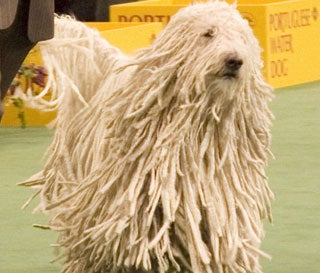Learn about dog breeds
Detailed information & photos on over 190 different breeds
Description
The Komondor is a distinct breed. They are herd dogs from Hungary who are best known by their corded coat. The coat is anywhere from 8 to 11 inches long and is always white in color. The coat is reminiscent of a sheep’s coat and many think that is purposeful to help them blend in with their flock.
The Komondor has a large head and muzzle that are a little on the short side. The eyes are dark in color and the ears are rounded and hang down. They look as if they are part of the coat. The body includes the deep, wide chest and muscular breast with a drawn up belly. The tail hangs down. They should have an overall look of strength.
Coat Description
The fur of the Komondor is its crowning glory. It is a dual coat but the two layers come together to form the characteristic felt look. The dog may not have a fully corded coat until two years of age and it will continue to full length until five years of age. As a pup the coat will be soft and eventually turn into long curls then cords. The cords are soft to the touch. The development of the coat is purely decided by age and naturally occurs.
History
The origin of the Komondor leads back to the Puli breed. It comes from other dog breeds that were brought to Hungary. This breed was developed as a sheep guard dog. It would guard flocks at night. They were also very good at standing up to any threats of the flock. It has been referenced as far back as the 16th century. They became popular in dog shows in the 1920s and have been popular pets ever since.
Temperament
The Komondor is a focused breed that does not play around a lot. They demand respect and they are very confident in who they are. They will analyze a person before considering them a friend. They are fiercely protective of their family and property. They are more than willing to fight when necessary. Socialization is important to curb the combative tendencies of this breed. The Komondor is very instinctive and trusts his instincts without fail. This requires strong obedience training. The strength of this breed should not be forgotten when working with it. Since it can be head strong you have to take a firm hand in any training to gain the respect you will need to succeed in teaching the dog.
Health Problems
The Komondor breed has several conditions that are common to larger sized dogs. They can suffer from hip dysplasia, bloat and skin problems. Overall, they are a healthy and hardy breed that will not suffer from extreme health issues.
Grooming
Grooming the Komondor involves plenty of care of the corded coat. It will not need brushing. Brushing is actually destructive to the coat. So, no brushing means, hand separation of the individual cords to stop tangling and give a good appearance. Bathing the Komondor is essential, but not an easy task. It can take many days for the dog to completely dry. One good thing to note is the breed does not really shed.
Other parts of grooming include trimming the nails, cleaning the teeth, and trimming hair between the toes. Professional grooming may be the best option with this if you do not have the time to devote to it.
Exercise
The Komondor will get enough exercise by itself if it is allowed to be outside where it can roam freely. It can be walked but it is important to understand its combative nature towards strangers and other animals. They do best in an isolated situation when exercising. They can be lazy and not motivated to do anything easily. They will sleep for hours on end and this is quite normal. They will get the exercise they need when they need it.
Training
The Komondor needs focused training. They have many personality traits that can become uncontrollable if they are not taught in a proper manner. They need good obedience education with a firm hand. It should be done by someone with experience in training the Komondor breed. They have to learn who is in charge or they will take over control. They should also be restrained from any combative behavior. They are smart and become bored so fast paced and varied work is necessary. They like to please, which can be used to the trainer advantage. They can be very respectful once that respect is earned.
Komondor's are not the best with children. They should always be watched because natural aggression can never be completely diminished. Training must be done as a puppy and they need to be introduced and welcomed into the family as a pup. Older dogs, if not trained, will be difficult to control. Using a professional trainer is important to help ensure this dog can live as a family pet.
Advertise | Privacy Policy | Terms of Use | Contact Us © Copyright 2004-2024 PupCity.com. All rights reserved.
